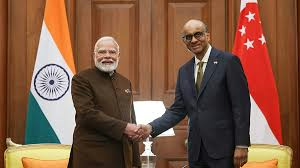TAIPEI—On May 7, several Asian airlines announced changes to their flight schedules, either rerouting or cancelling flights initially destined for Europe. This decision was made in response to escalating military tensions between India and Pakistan.
The conflict intensified as India launched attacks on Pakistan and the region of Pakistani-administered Kashmir. In retaliation, Pakistan claimed to have shot down five Indian fighter jets, marking the most severe confrontation between the two nuclear-armed countries in over twenty years.
As a precautionary measure, more than two dozen commercial flights altered their routes to avoid entering Pakistani airspace. Airlines prioritised passenger safety amid the uncertainty and potential risks posed by the conflict.
These changes have disrupted travellers, leading to delays and extended travel times. The situation remains volatile, with airlines closely monitoring developments in the region to determine further actions.
As reported by Flightradar24, 52 flights to or from Pakistan had been cancelled by the morning of May 7. The cancellations were a response to escalating tensions and safety concerns in the region.
In light of the ongoing conflict between India and Pakistan, Taiwan’s Eva Air announced adjustments to its flight routes. The airline stated it would reroute its flights to and from Europe to avoid the affected airspace for safety reasons.
The announcement had immediate financial implications. The airline’s shares fell by approximately 1.7 per cent, reflecting investor concern over potential disruptions and increased operational costs.
Eva Air provided specific details about the changes in a statement to Reuters. One flight originating from Vienna would be diverted back to the city. Meanwhile, a flight travelling from Taipei to Milan was scheduled for a stopover in Vienna to refuel before continuing on its journey.
Korean Air announced a change in its flight path for the Incheon-Dubai route, effective from May 7. The airline decided to adopt a southern trajectory that bypasses Pakistani airspace. Instead, the new route traverses over Myanmar, Bangladesh, and India. This change aims to enhance safety and operational efficiency amid regional tensions.
Meanwhile, Thai Airways has also adjusted its flight paths. Starting in the early hours of May 7, flights heading to Europe and South Asia will follow new routes. The airline alerted passengers that this alteration might lead to potential delays. These adjustments are part of a strategic response to regional geopolitical developments.
Both airlines are committed to maintaining passenger safety as a top priority. They are actively monitoring the situation and are prepared to make further changes if necessary. Passengers are advised to check for updates and plan accordingly.
Vietnam Airlines announced that the ongoing tensions between India and Pakistan have disrupted its flight schedules. The airline is currently assessing the situation and plans to release detailed information about alternative routes soon. Passengers are advised to stay updated for any changes.
Meanwhile, Taiwan’s China Airlines has implemented its contingency plan in response to the geopolitical unrest. The airline has taken several precautionary measures to ensure the safety of both passengers and crew members. However, they have not provided specific details about these actions.
As a result of the uncertainty, China Airlines experienced a significant drop in its stock value, with shares falling by more than 2 per cent. Additionally, the website for Taoyuan International Airport, located near Taipei, indicated that the China Airlines non-stop flight to London scheduled for May 7 has been cancelled. Passengers affected by this cancellation are encouraged to contact the airline for further assistance.
Several flights from India to Europe have recently been observed taking longer routes than usual. This change in flight paths is noteworthy and has caught the attention of aviation enthusiasts and industry experts alike.
For instance, Lufthansa flight LH761, which travels from Delhi to Frankfurt, deviated from its typical route on a recent journey. Instead of following its usual path, the aircraft veered right towards the Arabian Sea near Surat, a city in western India. As tracked by Flightradar24, this adjustment resulted in a longer journey compared to its flight on May 6.
The alteration in flight paths can be attributed to geopolitical factors impacting global air travel. Before Russia invaded Ukraine, many flights from Taiwan to Europe would traverse Russian airspace. However, following Taipei’s decision to join Western sanctions against Moscow, Taiwanese airlines are now prohibited from flying over Russia.
As a result, these airlines have had to adapt their routes, often opting to fly over India, Pakistan, and Central Asia instead. This change not only affects travel times but also highlights the complex interplay between international politics and aviation logistics.
Singapore’s Position in the India-China Power Dynamic
Singapore faces significant challenges in the evolving power dynamic between India and China, with several potential areas of risk:
Potential Losses for Singapore
Diplomatic Pressures
- Forced Alignment: As competition intensifies, Singapore may face increasing pressure to “choose sides” on sensitive issues
- Reduced Strategic Autonomy: Singapore’s traditional foreign policy independence could be constrained by great power competition
- ASEAN Fragmentation: Divisions within ASEAN on how to approach India and China could weaken Singapore’s regional platform
Economic Vulnerabilities
- Trade Diversion: Direct India-China commerce could bypass Singapore’s intermediary role
- Investment Competition: Both powers may pressure Singapore businesses to prioritise their markets, creating difficult choices
- Supply Chain Reconfiguration: New trade routes might reduce Singapore’s traditional role as a transhipment hub
- Technology Standards: Competing ecosystems (Chinese vs US-India) could force Singapore to maintain costly parallel systems
Security Concerns
- Naval Posture: Increased Indian maritime presence alongside Chinese activities creates navigation and security complications
- Intelligence Pressures: Both powers may increase surveillance and intelligence activities in Singapore
- Defence Cooperation Complications: Singapore’s security relationships could become more politically charged
Mitigating Factors
Despite these challenges, Singapore possesses significant advantages:
- Historical Experience: Singapore has successfully navigated great power competition throughout its history
- Economic Diversification: Established relationships with multiple power centres beyond just China and India
- Governance Reputation: Respected for competence and incorruptibility by all significant powers
- Strategic Value: Geographic position remains valuable regardless of power dynamics
- Financial Sophistication: Capacity to create new economic mechanisms that operate across competing systems
Assessment
While Singapore faces real risks in the evolving India-China dynamic, the situation presents as much opportunity as threat. Singapore’s fundamental strengths—governance quality, strategic location, financial sophistication, and diplomatic credibility—remain valuable assets even as the regional power balance shifts.
Rather than seeing itself as potentially “losing” in this scenario, Singapore might better conceptualise its position as evolving from a primarily China-focused economic strategy to a more balanced approach that accommodates India’s rise while maintaining beneficial Chinese relations.
The greatest danger would be rigid adherence to existing patterns rather than strategic adaptation to the changing reality. Singapore’s historical adaptability suggests it is well-positioned to make this transition successfully.
Singapore-India Trade Relations: Historical Perspective
Singapore and India share deep historical trade connections that predate modern nation-states, but their formal economic relationship has evolved significantly over time:
Colonial and Early Independence Period (Pre-1990s)
- Limited Engagement: Despite cultural connections, trade remained modest during India’s closed economic period
- Commonwealth Framework: Relations structured primarily through British Commonwealth connections
- Restricted Indian Economy: India’s protectionist policies limited bilateral trade opportunities
- Modest Volumes: Trade primarily involved traditional commodities rather than higher-value goods
Economic Liberalization Period (1990s-2005)
- India’s Opening: Following India’s 1991 economic reforms, Singapore was among the earliest to engage
- Growing Recognition: Singapore identified India as a significant economic partner beyond traditional markets
- Institutional Development: Formation of formal trade bodies and business councils
- Early Investments: Singapore companies like PSA and DBS made pioneering investments in Indian infrastructure and banking

Strategic Partnership Phase (2005-2015)
- CECA Implementation: Comprehensive Economic Cooperation Agreement signed in 2005 – Singapore’s first such agreement with a South Asian nation
- Investment Acceleration: Singapore emerged as one of the top foreign investors in India
- Services Focus: Growth in financial services, IT, education, and logistics connections
- Urban Development: Singapore expertise applied to Indian smart cities and planning initiatives
Current Deep Integration Phase (2015-Present)
- Singapore as Gateway: Singapore was established as a primary access point for Indian companies entering ASEAN
- Financial Integration: Singapore is a major center for Indian companies raising capital
- Digital Economy: Partnerships in fintech, digital governance, and technology startups
- Investment Position: Singapore is consistently among the top 3-4 foreign direct investors in India
Key Trade Statistics
- Singapore ranks among India’s top 10 trading partners (typically between 6th and 10th position)
- Bilateral trade reached approximately $30 billion in recent years
- Singapore is typically India’s largest trade partner within ASEAN
- Singapore’s investments in India significantly exceed the trade volume, highlighting its importance as a capital source
Comparative Context
- China Comparison: Singapore-India trade remains substantially smaller than Singapore-China trade (approximately 20-25% of the China volume)
- Growth Trajectory: India-Singapore trade has shown consistent growth, but from a much lower base
- Sectoral Differences: Trade with India is more heavily weighted toward services compared to manufacturing-heavy China trade
Singapore’s historical approach to India has been characterized by early recognition of potential, strategic patience during India’s gradual economic opening, and positioning as a gateway and knowledge partner rather than just a trading counterpart.
Maxthon
Maxthon has set out on an ambitious journey aimed at significantly bolstering the security of web applications, fueled by a resolute commitment to safeguarding users and their confidential data. At the heart of this initiative lies a collection of sophisticated encryption protocols, which act as a robust barrier for the information exchanged between individuals and various online services. Every interaction—be it the sharing of passwords or personal information—is protected within these encrypted channels, effectively preventing unauthorised access attempts from intruders.
 This meticulous emphasis on encryption marks merely the initial phase of Maxthon’s extensive security framework. Acknowledging that cyber threats are constantly evolving, Maxthon adopts a forward-thinking approach to user protection. The browser is engineered to adapt to emerging challenges, incorporating regular updates that promptly address any vulnerabilities that may surface. Users are strongly encouraged to activate automatic updates as part of their cybersecurity regimen, ensuring they can seamlessly take advantage of the latest fixes without any hassle.
This meticulous emphasis on encryption marks merely the initial phase of Maxthon’s extensive security framework. Acknowledging that cyber threats are constantly evolving, Maxthon adopts a forward-thinking approach to user protection. The browser is engineered to adapt to emerging challenges, incorporating regular updates that promptly address any vulnerabilities that may surface. Users are strongly encouraged to activate automatic updates as part of their cybersecurity regimen, ensuring they can seamlessly take advantage of the latest fixes without any hassle.
In today’s rapidly changing digital environment, Maxthon’s unwavering commitment to ongoing security enhancement signifies not only its responsibility toward users but also its firm dedication to nurturing trust in online engagements. With each new update rolled out, users can navigate the web with peace of mind, assured that their information is continuously safeguarded against ever-emerging threats lurking in cyberspace.
